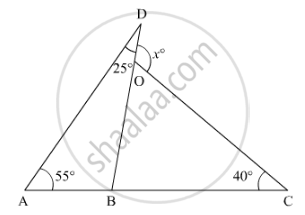Advertisements
Advertisements
Question
D is a point on the side BC of a ∆ABC such that AD bisects ∠BAC. Then ______.
Options
BD = CD
BA > BD
BD > BA
CD > CA
Solution
D is a point on the side BC of a ∆ABC such that AD bisects ∠BAC. Then BA > BD.
Explanation:
Given, ∆ABC such that AD bisects ∠BAC
∴ ∠BAD = ∠CAD ...(i)
In ∆ACD, ∠BDA is an exterior angle.
∴ ∠BDA > ∠CAD [∵ Exterior angle > interior opposite angle] ...(i)
⇒ ∠BDA > ∠BAD ...[From equation (i)]
⇒ BA > BD ...[Side opposite to greater angle is greater]
APPEARS IN
RELATED QUESTIONS
Prove that the medians of an equilateral triangle are equal.
Find the measure of each exterior angle of an equilateral triangle.
Angles A, B, C of a triangle ABC are equal to each other. Prove that ΔABC is equilateral.
ABC is a triangle and D is the mid-point of BC. The perpendiculars from D to AB and AC are equal. Prove that the triangle is isosceles.
Fill the blank in the following so that the following statement is true.
In a ΔABC if ∠A = ∠C , then AB = ......
In a ΔABC, if ∠B = ∠C = 45°, which is the longest side?
Which of the following statements are true (T) and which are false (F)?
Sum of any two sides of a triangle is greater than twice the median drawn to the third side.
ABC is a triangle. The bisector of the exterior angle at B and the bisector of ∠C intersect each other at D. Prove that ∠D = \[\frac{1}{2}\] ∠A.
In the given figure, the value of x is ______.

In ∆ABC, AB = AC and ∠B = 50°. Then ∠C is equal to ______.
